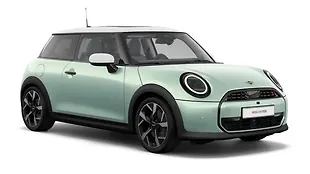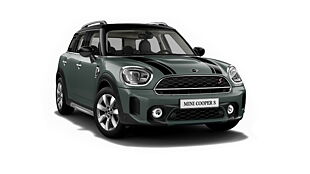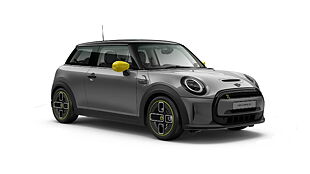What is it?

A fashion accessory for the enthusiasts. We had Mini Convertible in India before – a car driven by a paltry 1.6-litre unit producing 122bhp and performance no better than any of the C-Segment sedans. It didn’t matter much considering the purpose; for those looking to be in spotlight, it was a no-brainer. The new one seems to be as good in those aspects, but with the 190bhp engine it promises to be a lot more.
The Coopers, based on the new UKL platform, are much larger than the predecessors and to a large extent dishonest to their name. To think of it, not being ‘mini’ it isn’t such a bad thing, as they offer more practicality. The convertible mirrors the three-door hardtop Mini in terms of dimensions, which is 98mm longer, 44mm wider and 7mm taller than the previous car. Also, the wheelbase is longer by 28mm at 2,429mm.

The design, though a continuation of the previous cars, is more serious and aggressive. The front of the car looks busy with too many differently shaped elements; the grille is extra-large with curved ends, there is a rectangular air dam in the bumper and the headlamps have an oval shape. The flared wheel arches give it some substance and the stance is of a car that means business. Overall it isn’t something I will call beautiful – striking yes, but not pretty.
The side and rear profile are more flowing. It looks like a classic from these angles, especially with part of the roof visible tucked behind the second row, when folded. The rear design is simplistic, which is great; I specially love the centrally positioned twin exhaust.
Like always, the Mini Convertible has a canvas top. The mechanicals are new, the roof opens and shuts in 18 seconds at up to the speed of 30kmph. The Mini design with the steeply racked windshield helps, it automatically deflects wind and the cabin, even when the roof is down, is calm.
How is it on the inside?

Lot more spacious than the previous generation car. The front was never much of a problem, but even here there is additional shoulder room and headroom. The back space has also improved a bit with the longer wheelbase, but even then it isn’t sufficient for adults. But for a change, now at least the kids at the back won’t be complaining about the lack of space.
The typical circular theme of the Mini continues. A large round infotainment system sits in the middle of the dashboard, occupying the place that housed the speedometer in the previous car. I miss that one detail – it looked super cool and retro, in line with rest of the design. Other things that are round include the instrument cluster, the door knobs, air vents and rest of the dials. The good things retained from the previous car are the toggle switches – there are plenty including a large red one for engine start / stop.

It has a boot capacity of 215litres when the roof is up. When pulled down and occupying part of the boot, there is just over 160litres of space at the back.
How does it drive?

Mini is offering the car with the 2.0-litre turbocharged petrol engine producing 189bhp and 280Nm of torque. Those are impressive figures and along with the hardtop Cooper S, they make it the most powerful hatchback in the country.
The engine is connected to the front wheels via the six-speed automatic transmission. It is an old unit, which has been upgraded for this car; it works fairly well, but still slower compared to the dual-clutch boxes that we have become used to in the premium cars. There is some amount of lag, but once the engine comes to life the performance is noteworthy. Also, the lag when compared to the previous car is much less pronounced. It has a claimed 0 to 100kmph time of 7.1 seconds, just half a second slower than the hardtop Cooper S. To delight the enthusiast further, it also makes a ferocious sound when floored.

The thing that I liked the most in the new Mini is the ride and handling. The ride isn’t too harsh anymore; it was almost comfortable over all the potholes and speed breakers on the narrow Goa roads. But all of this only at slow speeds, push the car on the bad roads and it is clunky and uncomfortable as ever. There is a little bit of body roll, which will come as a big surprise for a Mini. Compared to the Cooper S it is a soft car; taking down the roof reduces the structural rigidity to some extent and it seems like a plausible reason for the softer set up.
If there is one thing that this Mini Convertible excels at, apart from being a flashy eye-candy, it is the performance.
Why should I buy one?

The Mini Cooper Convertible is sort of a split personality. With the roof in place and the car set to sports mode, it is good enough to do track days on most demanding of circuits. Take down the top and go for a spin in the city and at Rs 34.9 lakh it is one of the easiest and affordable ways of getting attention in an automobile.
For the enthusiast, the hardtop Cooper S would be the ideal bet, but if you have someone at home, who insists on owning a flashy car, the Convertible S offers the best of both worlds. Unfortunately, it still can’t be the only car you own; despite the increased dimensions, it still scores poorly on practicality.
Where does it fit it?
There is no direct competition for the Mini Cooper Convertible in India or in fact anywhere else in the world.
Photography by: Sanchit Arora

![MINI Cooper Convertible [2016-2018] Exterior MINI Cooper Convertible [2016-2018] Exterior](https://imgd.aeplcdn.com/642x361/cw/ec/22674/Mini-Cooper-S-Exterior-69678.jpg?v=201711021421&wm=1&q=80)
![MINI Cooper Convertible [2016-2018] Right Rear Three Quarter MINI Cooper Convertible [2016-2018] Right Rear Three Quarter](https://imgd.aeplcdn.com/642x361/cw/ec/22674/Mini-Cooper-S-Right-Rear-Three-Quarter-69685.jpg?v=201711021421&wm=1&q=80)
![MINI Cooper Convertible [2016-2018] Rear View MINI Cooper Convertible [2016-2018] Rear View](https://imgd.aeplcdn.com/642x361/cw/ec/22674/Mini-Cooper-S-Rear-view-69684.jpg?v=201711021421&wm=1&q=80)
![MINI Cooper Convertible [2016-2018] Rear View MINI Cooper Convertible [2016-2018] Rear View](https://imgd.aeplcdn.com/642x361/cw/ec/22674/Mini-Cooper-S-Rear-view-69686.jpg?v=201711021421&wm=1&q=80)
![MINI Cooper Convertible [2016-2018] Rear View MINI Cooper Convertible [2016-2018] Rear View](https://imgd.aeplcdn.com/642x361/cw/ec/22674/Mini-Cooper-S-Rear-view-69689.jpg?v=201711021421&wm=1&q=80)
![MINI Cooper Convertible [2016-2018] Left Front Three Quarter MINI Cooper Convertible [2016-2018] Left Front Three Quarter](https://imgd.aeplcdn.com/642x361/cw/ec/22674/Mini-Cooper-S-Left-Front-Three-Quarter-69680.jpg?v=201711021421&wm=1&q=80)
![MINI Cooper Convertible [2016-2018] Front View MINI Cooper Convertible [2016-2018] Front View](https://imgd.aeplcdn.com/642x361/cw/ec/22674/Mini-Cooper-S-Front-view-69679.jpg?v=201711021421&wm=1&q=80)
![MINI Cooper Convertible [2016-2018] Dashboard MINI Cooper Convertible [2016-2018] Dashboard](https://imgd.aeplcdn.com/642x361/cw/ec/22674/Mini-Cooper-S-Dashboard-69693.jpg?v=201711021421&wm=1&q=80)
![MINI Cooper Convertible [2016-2018] Image MINI Cooper Convertible [2016-2018] Image](https://imgd.aeplcdn.com/272x153/cw/ec/22576/Mini-Cooper-Convertible-Right-Front-Three-Quarter-69481.jpg?wm=0&t=191133733&t=191133733&q=80)
























